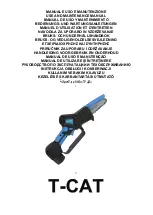
DIAMOND BLADES
Allowed Types Of Blades
This machine may use diamond blades only.
NOTE: Abrasive wheels may not be used on this machine.
•
Only use either segmented or continuous rim diamond blades.
•
If the diamond blades are segmented, the maximum allowable peripheral gap between segments is
10mm and must be with a negative rake angle.
•
Only diamond blades of 355mm (14”) or less may be used.
•
Blade thickness must be at least 2.0mm and no greater than 6.35mm
Blade Storage And Transport
Do not store or transport the machine with the blade mounted. Remove the blade and store in such a way that
it is protected from being bent or damaged when the machine is not in use-this will help prevent damage to
the blade.
A damaged blade can cause irregular conditions, this can cause imbalance and result in a hazard.
Always inspect new blades for storage or transport damage.
About Diamond Blades
Diamond blades consist of a steel core with diamond segments added to its periphery.
Diamond blades are available for different hardnesses of masonry materials, stone, concrete, reinforced
concrete, etc.
Some diamond blades are designed to be used wet only, while others are designed to be allowed to be used
dry. Refer to the blade manufacturer’s instructions.
Generally speaking, even if the blade is specified as a dry type blade, diamond tools always work better when
wet, and dry cutting should be limited to situations in which water cannot or should not be used. Water will
prevent the blade from overheating, greatly reduce the amount of harmful dust created by cutting, remove
the slurry from the cut, and extend the life of the blade. Diamond is the hardest substance known, but even
diamond is unable to withstand extreme overheating combined with the cutting forces involved. Dry cutting
of very hard materials such as porcelain or reinforced concrete will lead to rapid tool wear and possible failure.
The diamond impregnated segments in a sintered diamond blade operate on a principle of controlled
erosion. The blade does not cut the material, rather it grinds it away. The bond matrix holding the diamonds is
continually worn away by abrasion with the workpiece, exposing the harder diamonds to stand proud from the
bond matrix. A blade with good diamond exposure is a sharp blade. Blades made for cutting harder materials
will have a softer bond, allowing the diamonds project more aggressively (but will not last as long). Blades
made for cutting softer, abrasive materials will have a harder bond, allowing them to resist the abrasiveness of
the material and to last longer. The other factor is the grit size of the diamonds themselves: very hard materials
tend to require a finer grit size, while coarser grits will cut faster.
This erosion process causes heat and particles, which require water to cool and rinse free. Without adequate
water, the blade would overheat and be destroyed.
With too much water and not enough feed pressure, there would not be adequate erosion of the bond matrix
10
Содержание HBE 350
Страница 1: ...Operating Instructions Hand Saw HBE 350 Index 000 Original Instructions 10996853 23 03 2016 ...
Страница 17: ...WIRING 1 1 2 2 17 Temperature Sensor CARBON BRUSH CARBON BRUSH MOTOR ELECTRONICS UNIT AC SWITCH ...
Страница 23: ......
Страница 24: ......










































